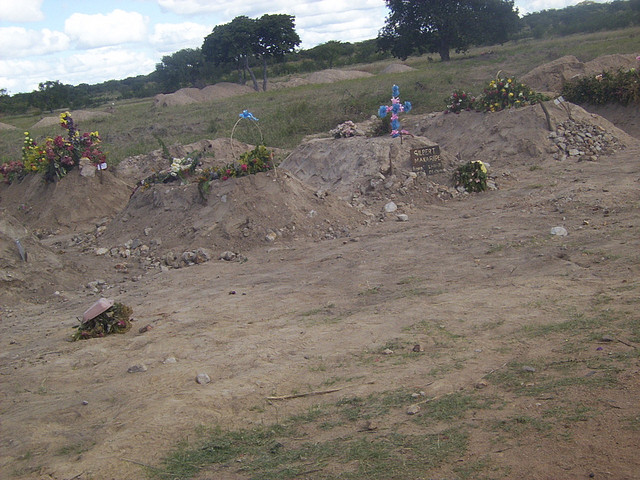
When we see glimpses of Africa, it’s usually because of a conflict, a safari, or a charity drive. Lanre Akinsiku, a writer from California, is spending a year traveling around Africa, going to lesser-known places to capture everyday moments.
Most tourists to Zimbabwe slide across the border to see the panoramic view of Victoria Falls, and then quickly hop back into Zambia or Botswana, where it’s supposedly safer. At Zimbabwe’s second most popular tourist attraction, the ruins of Great Zimbabwe, the guestbook is full of Zimbabwean names, although every few pages you’ll see that some curious European or Canadian passed through as well. In general, tourists avoid Zimbabwe because the news has frightened them into thinking they’ll die of cholera or be personally imprisoned by President Mugabe.
But there was a time when Zimbabwe had allure, when tourists weren’t afraid to come.
 Three middle-aged men tell me this as we share a cabin on a train through central Zimbabwe. When the train breaks down, these men grumble about how the train never used to break down. After we hop off the train to use the bathroom in the bushes, they point to the stainless steel toilet in our cabin and remember a time when it used to work. When I offer a slice of bread to one of the men, he takes it and reminisces about a time when food was delivered to the cabins. And then he tosses me a small bag of cheap rum and we lay in our bunk beds, stuck on a dead train, all of us quietly sipping our rum.
Three middle-aged men tell me this as we share a cabin on a train through central Zimbabwe. When the train breaks down, these men grumble about how the train never used to break down. After we hop off the train to use the bathroom in the bushes, they point to the stainless steel toilet in our cabin and remember a time when it used to work. When I offer a slice of bread to one of the men, he takes it and reminisces about a time when food was delivered to the cabins. And then he tosses me a small bag of cheap rum and we lay in our bunk beds, stuck on a dead train, all of us quietly sipping our rum.
The stories continue in Bulawayo, the country’s second largest city. Zimbabwe used to have excellent healthcare and education, says the taxi driver driving the beat-up minibus. (Even now, Zimbabwe maintains one of the highest adult literacy rates in the world, a legacy of that education system). Zimbabweans used to take vacations to London to buy things on the cheap because the Zimbabwean dollar was so strong, says one of the artists at the National Art Gallery. Zimbabwe used to be the jewel of Africa, says the guy sitting next to me, as we watch Zambia win the African Cup of Nations, a soccer tournament Zimbabwe didn’t qualify for. They tell these stories with a kind of obligatory zeal, the energy you need to relate tales so far removed from the present that they don’t feel quite real.
Bulawayo’s low, dignified, colonial-era buildings face onto wide streets lined with mature jacaranda trees, and I walk around feeling a kind of dour appreciation, like you do in a museum. Bulawayo’s central park, located just outside the city center, is all decay and neglect. Bubbling streams of sewage run through well-built canals. The aviary is empty, as is the skating rink, which is now overgrown by a mat of thick, healthy vines. The abandoned putt-putt golf course can only be identified thanks to a rusted sign, and nearby the miniature train station’s roof is caved in. There aren’t many people at the park, and the only noise comes from a bunch of truant school kids on a creaking swing set. It’s not hard to imagine how beautiful this park was in the past. No wonder everyone seems so nostalgic.
The only institutions growing in Bulawayo are the cemeteries. One day Brian, a local artist, invites me to a funeral. While we wait for the hearse to arrive, we walk through the cemetery, which is so overgrown with coarse, brown weeds that I can’t see most of the headstones. A few lithe gravediggers walk past us carrying dirt-caked shovels. Brian jokes that they’re too busy digging new graves to maintain the old ones. Finally, we stop at his brother’s grave. Brian knows its exact location; the headstone is covered under a brown bush. He stoops down and plucks a weed off, and we stand over the grave, silently picking the weeds off the small mound until we can see the headstone. Afterward, Brian waves to a part of the graveyard where the grass is so high that you wouldn’t know it was a graveyard unless someone told you. He says maybe we’ll go to his mother’s grave out there sometime.
By the time the hearse arrives, two other funerals have started. The attendees at all three funerals begin singing hymns in Ndebele. As we leave, I overhear someone say that, all things considered, it’s been a pretty light day; usually six or seven funerals are happening at the same time.
In America, we tend to think of pain as extraneous to the human experience. Suffering is an exception in what we hope will be happy and trouble-free lives. But as I move around Zimbabwe, where the parks have emptied and the cemeteries have filled, I see a different understanding of tragedy. Suffering is as integral to the human experience as joy. Bad things happen to everybody; why wouldn’t they? Brian shows no self-pity as we walk through a cemetery containing his entire family. Almost no one cries at the funeral. These are not signs of callousness or fatalism, but a recognition of life’s idiosyncrasies, the impenetrable calculus that determines who finds good fortune and who doesn’t.
People who haven’t spent time in Africa don’t understand this. No matter the problems plaguing the continent, I rarely meet people wallowing in self-pity. The West loves to feel sorry for Africa, to lament the continent’s challenges, but it’s hard to find Africans who feel sorry for themselves. And I think it’s because of a dogged belief I see from city to city and country to country: life will present challenges simply because that is what it is supposed to do, and we will go on and try to overcome them, simply because that is what we are supposed to do.
Lanre Akinsiku is a California-born travel and short story writer.
*Photo courtesy of Sokwanele – Zimbabwe.




Send A Letter To the Editors